#warming oceans
Explore tagged Tumblr posts
Text
California has gotten its first tropical storm watch ever. The last time a tropical storm hit California was in September of 1939 just after Hitler had started World War II. They didn't issue such watches in those days.
Major Hurricane Hilary in the Pacific is way stronger than low energy Hurricane Don in the Atlantic a few weeks ago; the latter spent only a few hours as a hurricane as it spun around aimlessly away from land.
Hilary will weaken from the current Category 4, but how much it will weaken is still not certain. If it maintains sustained winds of at least 74 MPH/119 KMH when it reaches California, then it will become California's first ever official hurricane.
Hurricane Hilary is expected to hit Southern California as a tropical storm, with a punch that could include flash flooding and significant amounts of rain, according to the National Hurricane Center. A tropical storm watch for much of Southern California was issued Friday morning. The National Weather Service's San Diego outpost said this was the first time such an advisory had ever been issued for the region.
As somebody who's been through half a dozen tropical cyclones on the East Coast, I would advise our California friends that rain is a bigger hazard than wind – in most cases. People in areas which have the potential for flooding should particularly remain on alert.
The 1939 storm, called El Cordonazo, became the first and only tropical storm to make landfall in the state in the 20th century, according to the National Weather Service. NWS says the storm, which was at one point a hurricane, originated off the southern coast of Central America before moving north and eventually coming ashore at San Pedro, California. Resulting floods from the storm killed at least 45 people across the Southern California region and caused $2 million in damage to structures and crops, the weather service reports. Another 48 people were also killed at sea.
There were far fewer people in California in 1939 when El Cordonazo caused deadly flooding.
Here is the current forecast for rainfall potential.
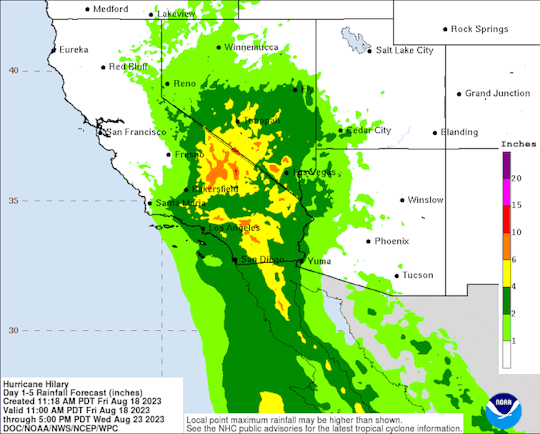
Keep up with the track of Hurricane Hilary here. Southern California should begin to feel the effects of Hilary on Sunday afternoon. Monitor local emergency information and follow advisories.
And if you're wondering why this is happening...
Our oceans are the warmest in recorded history. This is why it's so concerning
#hurricane hilary#california#potential flooding#california's first tropical storm since 1939#climate change#warming oceans#climate disasters
699 notes
·
View notes
Text
Excerpt from this story from Yale Environment 360:
For decades on the U.S. Mid-Atlantic coast, recreational anglers have braved the cold temperatures of late October and November to chase one of the region’s most iconic fish species, the striped bass. This season, just offshore of New Jersey and New York, the fall run was especially strong. “The amount of fish and [their size] was really, really high,” said Lou Van Bergen, a captain of Miss Barnegat Light, a 90-foot party boat out of Barnegat Light, New Jersey. “Every week, all the way through Thanksgiving, you could go out and catch nicer-sized fish.”
From the looks of the boat’s deck this fall, it would have been easy to assume that striped bass, once overfished to dangerously low numbers on the East Coast, had completed a remarkable comeback. Except that in the nearby Chesapeake Bay and in the Hudson River, where the fish return each spring to spawn, the hatching and maturation of juveniles “has been abysmal,” said John Waldman, an aquatic conservation biologist at the City University of New York. Waldman, an avid fisherman himself, called the low levels of striped bass recruitment, or spawning success, in these historically fertile estuaries “a real mystery.”
One way to better understand this apparent shift in striped bass recruitment and distribution in the Mid-Atlantic Bight— the coastal region that stretches from North Carolina’s Outer Banks to Massachusetts — is to look at similar shifts in the behavior of one of its key food sources, the Atlantic menhaden, a forage fish in the herring family. In recent years, menhaden have also been seen in high numbers off the New Jersey and New York coasts — Van Bergen described an early November trip in which the ocean surface was thick with menhaden for some 25 miles. But just like striped bass, menhaden numbers in the Chesapeake and other estuaries, where the fish was once reliably abundant, have been low.
“I don’t know if this is a larger cyclical pattern, if it’s driven by how they’re managed, or if it’s because the water temperature is increasing,” said Janelle Morano, a doctoral student at Cornell University who has been studying how menhaden distribution has changed along the U.S. East Coast over time. “But something is going on, and it is real.”
Taken together, the shifts in behavior of these two interconnected species resemble aspects of a phenomenon that is being observed across the planet, from land to sea: phenological mismatch.
Phenology is the seasonal timing of lifecycle events, like spawning and migration. Think of how honeybees emerge from their hives just as spring flowers bloom, or how in autumn, the monarch butterfly migrates south to Mexico as milkweed begins to die off in the United States. Phenological mismatch, however, occurs when these intricate, interspecies relationships fall out of sync due to changes in the environment. Terrestrial cases of phenological mismatch have been well documented. For example, detailed analysis has shown that, over the past 29 years, monarch migration has been delayed by six days due to warming temperatures, triggering mismatches with food availability during the journey and failures to reach overwintering sites.
But in the oceans, phenological mismatch has been far less studied. Every scientist interviewed for this story noted that while there has been good research on single-species phenology in marine environments, there remains precious little understanding of multispecies phenological mismatch. The subject, they said, urgently requires more focus because of the potential knock-on effects that mismatches could cause up and down the food chain. They also cautioned that all species, marine and terrestrial, are prone to natural swings in abundance, and that declines or increases can’t be pinned to any one stressor. Overfishing and stock management are just two external factors that may be influencing phenological mismatch in the world’s oceans. As the authors of a paper published in Nature Climate Change that focused on this lack of knowledge put it, “Given the complexity involved, accurately forecasting phenological mismatch in response to climate change is a major test of ecological theory and methods.”
29 notes
·
View notes
Text
The world’s coral reefs have been pushed into “uncharted territory” by the worst global bleaching event on record that has now hit more than 80% of the planet’s reefs, scientists have warned.
Reefs in at least 82 countries and territories have been exposed to enough heat to turn corals white since the global event started in January 2023, the latest data from the US government’s Coral Reef Watch shows.
Coral reefs are known as the rainforests of the sea because of their high concentration of biodiversity that supports about a third of all marine species and a billion people.
But record high ocean temperatures have spread like an underwater wildfire over corals across the Pacific, Atlantic and Indian oceans, damaging and killing countless corals.
Even reefs considered by scientists to be refuges from the ocean’s rising levels of heat have been bleached, Dr Derek Manzello, the director of Coral Reef Watch, said.
“The fact that so many reef areas have been impacted, including purported thermal refugia like Raja Ampat and the Gulf of Eilat, suggests that ocean warming has reached a level where there is no longer any safe harbour from coral bleaching and its ramifications,” he said.
Many areas have seen bleaching in back-to-back years, including the world’s biggest reef system, Australia’s Great Barrier Reef, where last week authorities declared a sixth widespread bleaching event in just nine years.
Australia’s other World Heritage-listed reef along the Ningaloo coast in Western Australia has seen its highest levels of heat stress on record in recent months.
Scientists on the other side of the Indian Ocean have reported bleaching in recent weeks affecting reefs off Madagascar and the east African coast, including South Africa’s World Heritage iSimangaliso wetland park.
Dr Britta Schaffelke, of the Australian Institute of Marine Science and coordinator of the Global Coral Reef Monitoring Network (GCRMN), said the event was unprecedented. “Reefs have not encountered this before.”
“With the ongoing bleaching it’s almost overwhelming the capacity of people to do the monitoring they need to do,” she said. “The fact that this most recent, global-scale coral bleaching event is still ongoing takes the world’s reefs into uncharted waters.
"[For] people who spend their entire working lives on monitoring and observing reefs and protecting reefs, and living alongside them and relying on them, seeing something like this must be devastating.
“Ecological grief is real. People who spend a lot of time under the water see it changing before their eyes,” she said.
The GCRMN is collating monitoring data for a status report due out next year, but Schaffelke said even that report would not give a full picture of the impact of the event.
Corals can recover from bleaching if temperatures are not too extreme, but surveys done in the months after the event have begun to paint a picture of widespread coral death.
Across Florida, an average of one in five corals were lost. On the Pacific side of Mexico, one area lost between 50% and 93% of its corals. Almost a quarter of corals were killed by heat last year in the remote Chagos Islands in the middle of the Indian Ocean.
Scientists described a “graveyard of dead corals” in the northern section of the Great Barrier Reef after bleaching in early 2024 that caused 40% of corals to die in one area in the south.
After the extreme heat of 2023, Coral Reef Watch was forced to add three new threat levels to its global bleaching alert system to represent the unprecedented heat stress corals had faced.
Melanie McField, the founder of the Healthy Reefs for Healthy People initiative in the Caribbean, said reefs had fallen quiet across the world.
“Bleaching is always eerie – as if a silent snowfall has descended on the reef … there is usually an absence of fluttering fish and an absence of the vibrant colours on the reef,” she said. “It’s an ashen pallor and stillness in what should be a rowdy vibrant reefscape.”
Dr Lorenzo Álvarez-Filip, a coral scientist at the National Autonomous University of Mexico, has been surveying reefs across the Mexican Caribbean and the Gulf of Mexico after the bleaching in 2023 and again in 2024.
He said the most devastating impact was the loss of reef-building corals, such as elkhorns, that help protect coastlines and support a multitude of other marine life.
“Many of the coral colonies I knew well, and which had survived [a major disease] outbreak just a few years earlier, died in a matter of weeks.
“The feeling of impotence combined with the need to at least document what was happening made me very anxious – this was particularly hard when we were about to dive in sites where we knew there were big aggregations of susceptible corals. In almost all cases, we ended up with a very depressing feeling when we confirmed that all or nearly all the coral had died.”
2 notes
·
View notes
Text
'Alarming drop off the cliff': Record low Antarctic sea ice triggers eme...
youtube
#climate change#climate crisis#climate#climate emergency#climate action#new zealand#nz#world news#politics#aotearoa#antarctica#sea ice#global warming#sea level rise#warming oceans#climate catastrophe#environment#Youtube
8 notes
·
View notes
Text



today's warm up: Little selkie sibling wants to go play!! (1:25 hr)
6K notes
·
View notes
Text

She's not like other girls
#She's suppose to be just making a pose but she kinda looks like she's crawling out of the ocean lmao#Making quick messy backgrounds is my drawing warm up now. Seems to have the same effect as drawing circles to me anyway#Also wanna study the anatomy of this weird pose from this meme#And tbh. I still don't get it. XD#Steven Quartz Universe#Connie Maheswaran#SU#Steven Universe#my shiz#connverse#I'm not like other girls meme#meme#I'm not like other girls#I like how Connie's hair had hung like a curtain when wet (and when lying down it looks like a puddle) I have had wished to see that again#I think her hair was long enough to do that again in The Movie and in Future#skedoobles
4K notes
·
View notes
Text

"as the sun sets,"
instagram | shop | commission info
#artists on tumblr#animated illustration#backgrounds#digital art#2d animation#myillust#background art#environment illustration#animated gif#sunset#cozy rooms#evening#ocean waves#reading nook#helloo! just wanted to share this quick little artwork i made! c: this was originally just a warm-up painting of the clouds#but i ended up liking the end result a looot so i added the window reading nook idea around it to really frame the clouds!#this really is a quick one heh so there's not much else to say - i really hope you'll like this!#and i hope you'll have a lovely day/night ahead!
5K notes
·
View notes
Text

^^^ This one didn't amount to anything. But I thought it would be interesting to take note of the first time I noticed any tropical disturbances during the 2024 Atlantic Basin Hurricane Season. That was Friday morning May 24th. Okay, it's still technically the pre-season but NOAA went into seasonal mode on May 15th at their tropical cyclone site.
This is expected to be a more active than usual season.
This hurricane season could be among the worst in decades, NOAA warns
Warm waters across the tropical Atlantic in May 2005 prompted warnings of an active hurricane season ahead. A record-smashing 28 storms formed, including Hurricane Katrina. Nearly two decades of global warming later, those late-spring ocean temperatures are cool compared with today’s record-hot waters. Government meteorologists issued a seasonal forecast Thursday that predicts that storms could develop at frequencies and with ferocity comparable to some of the worst seasons in the past 19 years. The National Oceanic and Atmospheric Administration forecast — which calls for 17 to 25 tropical storms, eight to 13 hurricanes and four to seven “major” hurricanes — underscores how dramatically the environment has shifted and increased the risk of destructive weather. The prediction is the most aggressive outlook the agency has ever made ahead of the start of hurricane season.
Yes, climate change is the main suspect.
Warming is allowing major storms to form significantly earlier during hurricane season, and also encouraging more to undergo rapid intensification more frequently in parts of the Atlantic basin such as the western Caribbean Sea. A study found that a growing number of tropical cyclones around the world have undergone what researchers called “extreme” rapid intensification, with their maximum sustained winds increasing by 57 mph or more within a 24-hour period.
The author mentioned that 2005 was a "record-smashing" season. But he did not mention that the 2005 record was itself smashed in 2020.
2020 Atlantic Hurricane Season
In 2020 we went all the way to Hurricane Iota in mid November.
Donald Trump was probably already too busy planning his coup in mid November 2020 to notice Hurricane Iota. But if he is returned to power he is essentially declaring war on Planet Earth.
No more going wobbly in climate fight, Trump supporters vow
Trump’s campaign utterances, and the policy proposals being drafted by hundreds of his supporters, point to the likelihood that his return to the White House would bring an all-out war on climate science and policies — eclipsing even his first-term efforts that brought U.S. climate action to a virtual standstill. [ ... ] Meanwhile, many of his former staffers are building out a comprehensive plan to decimate both climate policy and regulations on fossil fuels. And Trump allies expect that the former president would fill his next administration with officials who are even more hostile to efforts to address global warming.
Donald Trump is an enemy of the planet. The only way to defeat this real-life James Bond villain is to vote for Joe Biden.
#2024 atlantic basin hurricane season#tropical weather#noaa#tropical cyclones#warming oceans#climate change#hurricane iota#donald trump#drill drill drill#big oil#enemy of the planet#republicans#fossil fuels#election 2024#vote blue no matter who
6 notes
·
View notes
Text


Excerpt from this story from The Guardian:
The world’s coral reefs have been pushed into “uncharted territory” by the worst global bleaching event on record that has now hit more than 80% of the planet’s reefs, scientists have warned.
Reefs in at least 82 countries and territories have been exposed to enough heat to turn corals white since the global event started in January 2023, the latest data from the US government’s Coral Reef Watch shows.
Coral reefs are known as the rainforests of the sea because of their high concentration of biodiversity that supports about a third of all marine species and a billion people.
But record high ocean temperatures have spread like an underwater wildfire over corals across the Pacific, Atlantic and Indian oceans, damaging and killing countless corals.
The 84% of reefs exposed to bleaching-level heat in this ongoing fourth event compares with 68% during the third event, which lasted from 2014 to 2017, 37% in 2010 and 21% in the first event in 1998.
Even reefs considered by scientists to be refuges from the ocean’s rising levels of heat have been bleached, Dr Derek Manzello, the director of Coral Reef Watch, said.
Many areas have seen bleaching in back-to-back years, including the world’s biggest reef system, Australia’s Great Barrier Reef, where last week authorities declared a sixth widespread bleaching event in just nine years.
9 notes
·
View notes
Text
From the article:
As the climate is continuously changing and the atmosphere is warming, many scientists fear that fresh water from melting polar ice sheets could significantly disrupt—or collapse—the AMOC. While a decline of the AMOC would have grave consequences, a collapse would be truly catastrophic [...] However, studies about the AMOC's long term future are uncertain. Instead of predicting the future, a team of scientists from Woods Hole Oceanographic Institution (WHOI) quantified the past to help inform where we could be going. In a new paper published in Nature Communications, scientists found that the AMOC has not declined in the last 60 years [...] "Based on the results, the AMOC is more stable than we thought," Vogt said. "This might mean that the AMOC isn't as close to a tipping point as previously suggested."
#ocean currents#climate change#global warming#environment#ecology#ocean ecology#AMOC#research#good news#hope#tipping point
513 notes
·
View notes
Text
The unexpected jump in global temperatures since 2023 has helped fuel a relentless assault of associated disasters around the world, including the still-burning LA fires and the deadly Valencia floods, leaving researchers scrambling for explanations. Data from the world's oceans now reveal that an alarming acceleration in sea surface warming likely contributed. A new study from the University of Reading in the UK finds the tops of our oceans are warming more than four times faster than in the late 1980s.
Continue Reading.
395 notes
·
View notes
Text

Sharpening Our View of Climate Change with the Plankton, Aerosol, Cloud, ocean Ecosystem Satellite
As our planet warms, Earth’s ocean and atmosphere are changing.
Climate change has a lot of impact on the ocean, from sea level rise to marine heat waves to a loss of biodiversity. Meanwhile, greenhouse gases like carbon dioxide continue to warm our atmosphere.
NASA’s upcoming satellite, PACE, is soon to be on the case!
Set to launch on Feb. 6, 2024, the Plankton, Aerosol, Cloud, ocean Ecosystem (PACE) mission will help us better understand the complex systems driving the global changes that come with a warming climate.
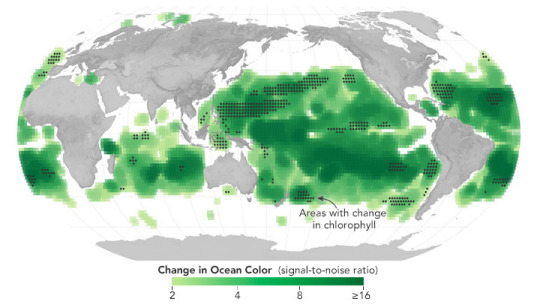
Earth’s ocean is becoming greener due to climate change. PACE will see the ocean in more hues than ever before.
While a single phytoplankton typically can’t be seen with the naked eye, communities of trillions of phytoplankton, called blooms, can be seen from space. Blooms often take on a greenish tinge due to the pigments that phytoplankton (similar to plants on land) use to make energy through photosynthesis.
In a 2023 study, scientists found that portions of the ocean had turned greener because there were more chlorophyll-carrying phytoplankton. PACE has a hyperspectral sensor, the Ocean Color Instrument (OCI), that will be able to discern subtle shifts in hue. This will allow scientists to monitor changes in phytoplankton communities and ocean health overall due to climate change.

Phytoplankton play a key role in helping the ocean absorb carbon from the atmosphere. PACE will identify different phytoplankton species from space.
With PACE, scientists will be able to tell what phytoplankton communities are present – from space! Before, this could only be done by analyzing a sample of seawater.
Telling “who’s who” in a phytoplankton bloom is key because different phytoplankton play vastly different roles in aquatic ecosystems. They can fuel the food chain and draw down carbon dioxide from the atmosphere to photosynthesize. Some phytoplankton populations capture carbon as they die and sink to the deep ocean; others release the gas back into the atmosphere as they decay near the surface.
Studying these teeny tiny critters from space will help scientists learn how and where phytoplankton are affected by climate change, and how changes in these communities may affect other creatures and ocean ecosystems.
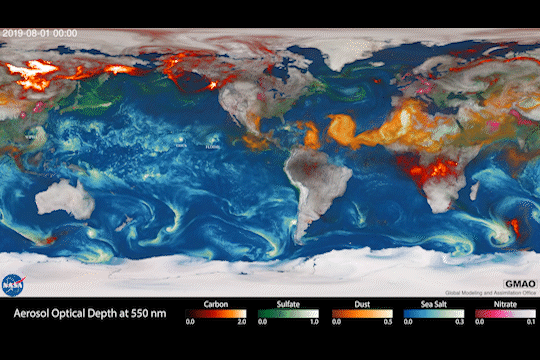
Climate models are one of our most powerful tools to understand how Earth is changing. PACE data will improve the data these models rely on.
The PACE mission will offer important insights on airborne particles of sea salt, smoke, human-made pollutants, and dust – collectively called aerosols – by observing how they interact with light.
With two instruments called polarimeters, SPEXone and HARP2, PACE will allow scientists to measure the size, composition, and abundance of these microscopic particles in our atmosphere. This information is crucial to figuring out how climate and air quality are changing.
PACE data will help scientists answer key climate questions, like how aerosols affect cloud formation or how ice clouds and liquid clouds differ.
It will also enable scientists to examine one of the trickiest components of climate change to model: how clouds and aerosols interact. Once PACE is operational, scientists can replace the estimates currently used to fill data gaps in climate models with measurements from the new satellite.

With a view of the whole planet every two days, PACE will track both microscopic organisms in the ocean and microscopic particles in the atmosphere. PACE’s unique view will help us learn more about the ways climate change is impacting our planet’s ocean and atmosphere.
Stay up to date on the NASA PACE blog, and make sure to follow us on Tumblr for your regular dose of sPACE!
1K notes
·
View notes
Text



today's warm up: Mam finally let her littlest play with the big kids 🌊🌊
#anonbeadraws#digital art#selkie#today's warm up#art#ocean#seal#artists on tumblr#im liking this sketchy style#so fun#fantasy#warm
864 notes
·
View notes
Text
If my mutual wants a jay ferin then she will get a jay ferin ‼️‼️ [ @isabelopaque ]

#my art#jrwi#TY FOR THE REQUEST I really like drawing jay I always get to have fun with the warm colors :3#associated listening is the chorus of once more for the ocean slothrust
197 notes
·
View notes
Text
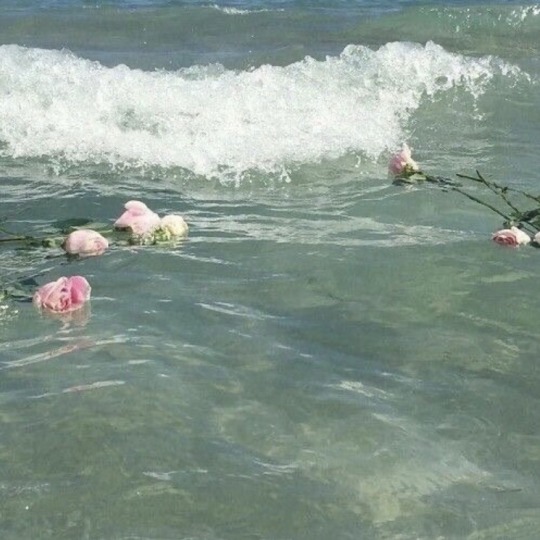



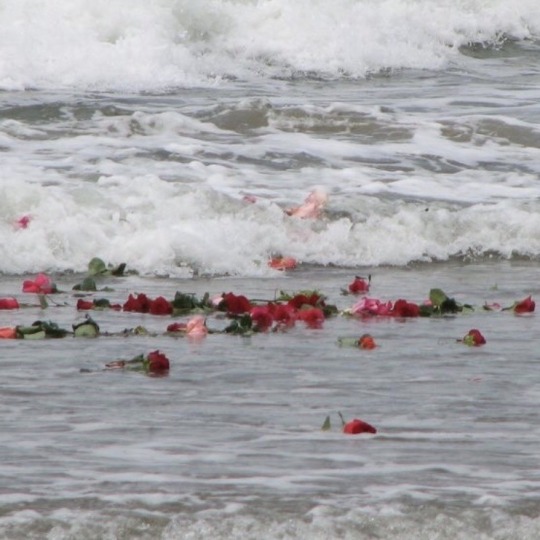




#a little bit of everything. warm water. flowers#ice. flowers on ice#fish. beauty <3#cottagecore#nature#naturecore#flowers#flowercore#water#watercore#moodboard#fish#ocean#sea#messy moodboard
3K notes
·
View notes
Text
despite that drawing, i don't think HC grian has a period, BUT he did have one back on Evo, before becoming a Watcher.
i think when the cramps were bad he'd just lay shirtless on the beach. The hot sand works as a heating pad
#sorry period headcanon i do what i want#sand can get SOOO hot in the sun. but the ocean breeze keeps you cool anyway !#(also ? shirtless ? outside ? before all the catholic shame got to him !)#i need to lay shirtless on a beach . half buried. the warm sand will save me
114 notes
·
View notes